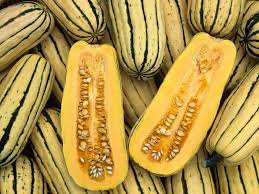Squash rind refers to the outer layer or covering of a squash fruit. Squash is a type of fruit that belongs to the gourd family (Cucurbitaceae), which includes various species such as pumpkins, zucchinis, butternut squashes, acorn squashes, and others.
The squash rind is the tough and often thick outer layer of the fruit, which provides protection to the internal parts of the fruit as it grows and matures. The rind can vary in color, texture, and thickness depending on the specific type of squash.
In some culinary contexts, squash rind is used in cooking, particularly in dishes where it can be eaten or used in various ways. For example, some recipes utilize squash rind in pickling, stir-frying, or using it as an ingredient in soups or stews.
Botanically, the rind is an important part of the squash fruit, as it helps protect the seeds and flesh inside, providing a barrier against environmental factors and potential predators. The rind also plays a role in the dispersal of the seeds, as it helps the fruit to survive until it is ready for consumption or until the seeds are ready for dispersal.
The Economic Importance and Uses of Squash Rind

Squash rind, often overlooked, can have several economic and practical uses. Squash rind refers to the outer skin or peel of various types of squash, such as pumpkin, butternut squash, acorn squash, and others.
Here are the economic importance and uses of squash rind:
1. Cooking Ingredients: Squash rind can be used in various culinary dishes, including soups, stews, and curries, providing added flavor, nutrition, and texture to the dishes.
2. Pickling and Fermenting: Squashs rind can be pickled or fermented to make tasty and preserved condiments, similar to cucumber pickles.
3. Livestock Feed: Squash rind can be utilized as a feed ingredient for livestock, particularly for animals like cattle and pigs, providing additional nutrients and dietary fiber.
4. Organic Fertilizer: Squashs rind can be composted to create organic fertilizer, enriching the soil with valuable nutrients and improving its structure.
5. Mulch and Soil Amendment: The rind can be chopped and used as a natural mulch or soil amendment, aiding in moisture retention and weed suppression.
Read Also: Squash Leaves: Economic Importance, Uses, and By-Products
6. Biofuel Production: Squash rind, along with other organic waste, can be used to generate biogas or biofuels through anaerobic digestion, contributing to renewable energy sources.
7. Decorative Crafts: Squash rind can be dried and used in various crafts, such as creating decorative pieces like coasters, bowls, or ornaments.
8. Natural Dye: The rind can be utilized as a natural dye, providing color to fabrics or other materials in arts and crafts.
9. Health Supplements: Some compounds present in squash rind may have potential health benefits, leading to the development of supplements or medicinal products.
10. Reduced Food Waste: Utilizing squashs rind ensures that less food waste is generated, contributing to sustainable practices and reducing the strain on waste management systems.
11. Commercial Production: Large-scale processing and utilization of squashs rind in food products or other industries can create employment opportunities and generate economic value for farmers and businesses.
12. Research Purposes: Squash rind can be used for research purposes to study its nutritional composition, potential applications, and other properties, aiding in further discoveries and advancements.
The Products and By-products That Can Be Derived From Squash Rind
Squash rind, which is often discarded, can actually be utilized to create various products and by-products, promoting sustainability and reducing waste.
Here’s a list of potential products and by-products derived from squash rind, along with explanations:
1. Squash Rind Pickles: Squash rind pickles are made by preserving squash rind in a vinegar-based brine infused with spices and seasonings. This product extends the use of squash rind by creating a tangy and flavorful condiment.
Read Also: Dates Calyx: Economic Importance, Uses and By-Products
2. Squash Rind Chutney: Chutney is a relish-like condiment made by cooking squash rind with spices, vinegar, sugar, and sometimes fruits. It’s a versatile accompaniment to various dishes, reducing waste and adding flavors.
3. Squash Rind Jam: Jam is created by boiling squashs rind with sugar and fruit juices to produce a sweet spread. It transforms the rind into a delightful and unexpected product, minimizing waste and maximizing utility.
3. Squash Rind Soup or Broth: Squash rind can be used to make a nutritious and flavorful soup or broth. Boiling the rind with other ingredients can yield a hearty soup base or broth for various dishes.
4. Squash Rind Powder: Dehydrated squash rind can be ground into a powder, which can be used as a seasoning or flavor enhancer in a variety of recipes, such as soups, stews, or sauces.
5. Squash Rind Chips: Squash rind can be thinly sliced, seasoned, and dehydrated or baked to make crispy and healthy chips. This provides a tasty snack option and reduces food waste.
6. Squash Rind Infused Oil: Squash rind can be infused in oil to impart its flavors and nutrients. The infused oil can be used for cooking, salad dressings, or as a flavoring agent.
7. Squash Rind Fertilizer: Composting squashs rind or using it as organic fertilizer enriches the soil with nutrients, promoting healthy plant growth in gardens or farms.
8. Squash Rind Animal Feed: Squash rind can be used as animal feed, particularly for livestock or poultry, providing a source of nutrition and reducing feed costs.
9. Squash Rind Biogas Production: Squash rind can be used in biogas production through anaerobic digestion, producing methane and other gases for energy.
In conclusion, utilizing squash rind in these various ways not only helps minimize waste but also contributes to sustainability, economic development, and the efficient utilization of available resources.
Read Also: How to Make Money from Glass Wastes

